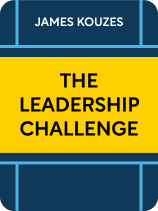

This article is an excerpt from the Shortform book guide to "The Leadership Challenge" by James M. Kouzes and Barry Z. Posner. Shortform has the world's best summaries and analyses of books you should be reading.
Like this article? Sign up for a free trial here .
What is visionary leadership? What are the key qualities of a visionary leader?
People expect a visionary leader to be forward-thinking. A forward-thinking leader creates a positive vision—one that engages people’s imaginations and emotions—and then works to make it happen.
Visionary leaders are not born, they are made, and there are specific steps you can take to make one of yourself.
Visionary Leadership
Often, visionary leaders have difficulty pinpointing where their visionary thinking comes from, chalking it up to intuition or a gut feeling. While these sources of inspiration are vague and hard to quantify, fortunately, there are specific steps you can take to prompt visionary thinking.
- Examine your past.
- Mind the present.
- Scout the future.
- Connect with your passion.
1. Examine Your Past
To properly see the future, first reflect on your history. When you look to the past, you better understand how you arrived at where you are now, and that in turn can inform your future decisions.
- If you’ve made mistakes in the past, studying them will prevent you from repeating them.
- If you made wise choices, reflecting on them will help you know what to do in similar situations.
Examining your past also helps you see how your values have shaped your life—either how your actions have been influenced by your values or have run counter to them. This can help you reassess whether you’re acting in accordance with those values or whether you need to change your behavior to honor them better.
2. Mind the Present
In order to envision a better future, be fully aware of your present—of trends, patterns, strengths and weaknesses in your organization, and challenges and conditions outside your organization. When you pay attention to your current world, you can better anticipate what’s to come.
Strive to notice things outside of your immediate reach of attention:
- Examine your workplace and community: Notice what people are doing that they weren’t doing five years ago: what they’re using or no longer using, how they’re working, what looks different today in your workplace or community.
- Listen to your team members: Notice their topics of conversation: what they say they need, what’s preventing them from doing their jobs, what they want to see changed.
It can be difficult to be consciously mindful of your surroundings because it’s easy to get caught up in the details and pressures of daily life. To prevent this, be proactive about becoming mindful: Set aside time every day to pause your activities and take stock of the world around you. This will allow you to spot larger trends and see opportunities you might otherwise have missed.
3. Scout the Future
A visionary leader thinks about the next project and the one after that (and after that).
- Be on the lookout for developments in your workplace, industry, or the wider world around you. Changes in technology, economics, arts, demographics, and politics, as well as changes within your organization, can affect your vision.
- Seek out information about trends and innovations through news feeds, podcasts, documentaries, and the like.
In scouting the future, look for opportunities and threats. Being aware of both will allow you to lead your organization more successfully and will encourage people to follow you more enthusiastically.
4. Connect With Your Passion
To envision the future, connect with your deepest passions. Your passion will drive your vision because it will point you in the direction you want to go and influence what vision of the future you’re willing to work for, suffer for, and sacrifice for.
No one else can tell you what your passion is—your passion and purpose are unique to you. Therefore, just as you spent time clarifying your values, also take time to clarify your passions. Once you have a clear idea of what will give your life meaning, you can effectively pass along your enthusiasm to others.
Case Study: Andrew Rzepa and Trainee Solicitors Group
Andrew Rzepa was the committee chair of lawyer trainees in Manchester, England, when a close affiliate group, Trainee Solicitors Group, arranged to hold a conference in his city. Even though he was not an official organizer for the event, he decided to make the conference a success and took the initiative to get others on board.
When enrollment for the event plateaued at 75 people, Andrew appealed to his colleagues to help boost attendance. He spoke to them passionately about what it would mean for their local organization to have this event be successful, and how good it would feel if they made that happen. He saw a specific possibility: He set a goal of increasing attendance to 300 and asked the other committee members if they were willing to personally commit to helping realize this goal. In the end, he successfully energized his colleagues and the final event attendance was 316 trainees.

———End of Preview———
Like what you just read? Read the rest of the world's best book summary and analysis of James M. Kouzes and Barry Z. Posner's "The Leadership Challenge" at Shortform .
Here's what you'll find in our full The Leadership Challenge summary :
- A field guide for becoming the kind of leader that other people want to follow
- The five principles of leadership and their associated guidelines
- Why before you can lead others, you must have a clear understanding of yourself






